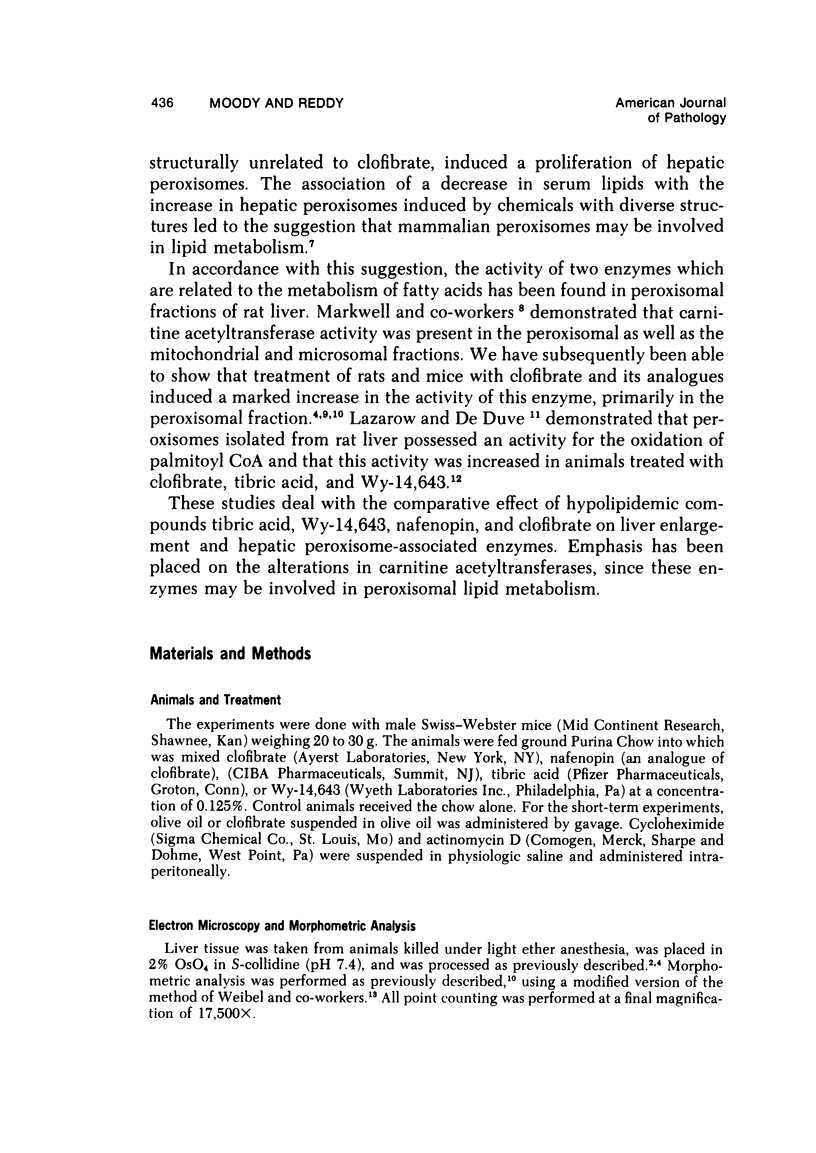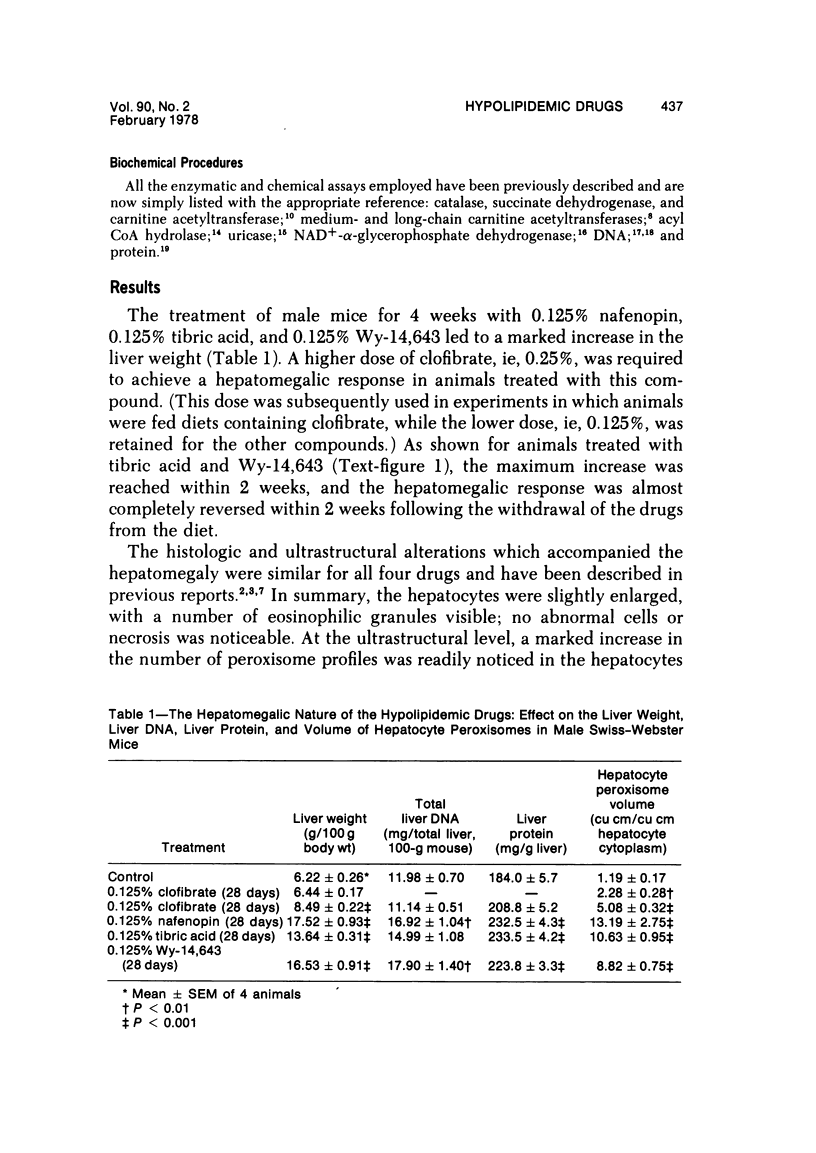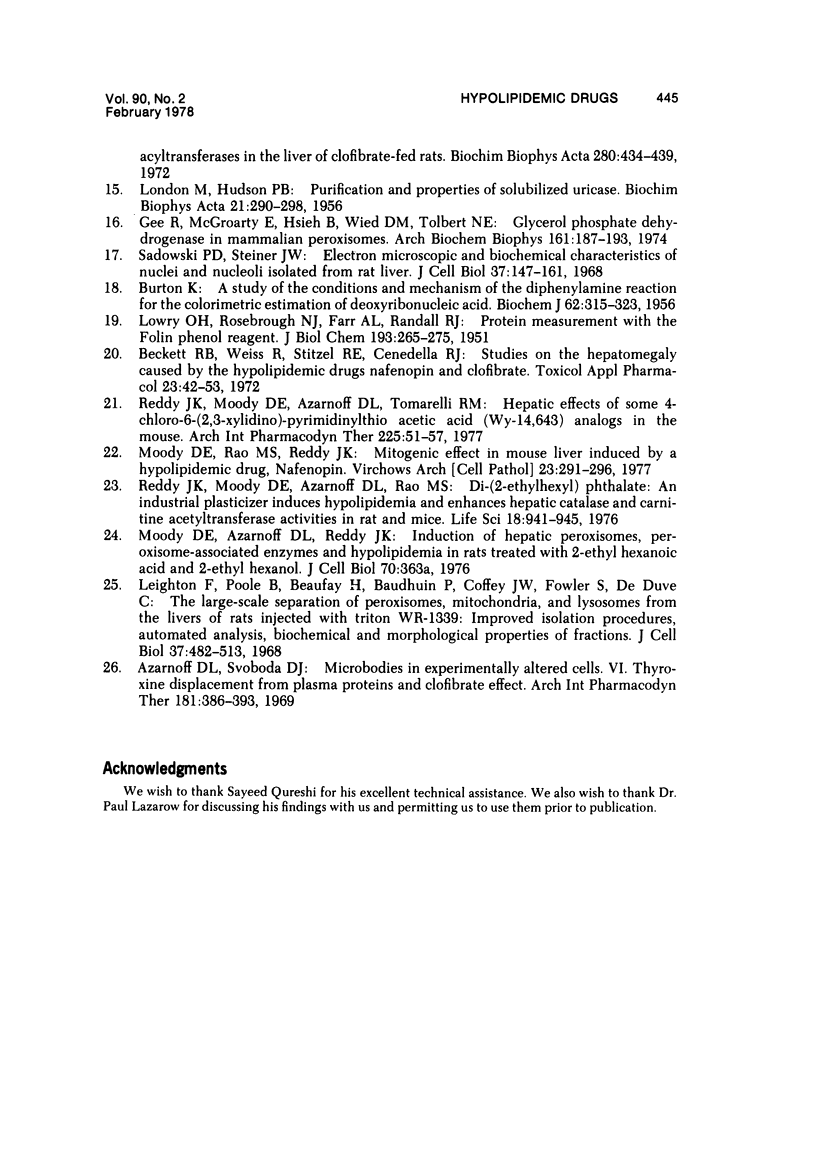Abstract
Male Swiss-Webster mice were fed diets containing four hypolipidemic agents which are known to induce proliferation of hepatic peroxisomes. Treatment with all four drugs (clofibrate; its structural analogue, nafenopin; and two drugs structurally unrelated to clofibrate, tibric acid and Wy-14,643) produced a marked hepatomegaly in the mice. The extent of the increase in liver weight correlated well with the increases in total hepatic DNA and in the collective volume of hepatocyte peroxisomes. Treatment with these drugs also produced similar increases in the activities of peroxisome-associated enzymes. The most dramatic increases were noted in the activities of the short-chain (8- to 26-fold) and medium-chain (4- to 11-fold) carnitine acyltransferase. Significant increases were also noted in the activities of catalase (twofold to threefold), alpha-glycerophosphate dehydrogenase (twofold to threefold) and the long-chain carnitine acyltransferase (twofold to fourfold). Activity of the latter enzyme, however, is not known to be associated with peroxisome fractions. Concomitant administration of actinomycin D or cycloheximide with a single oral dose of clofibrate diminished the increases in liver weight and carnitine acyltransferase which occurred with clofibrate treatment alone. The finding that the major increase in activity of peroxisome enzymes occurred in those associated with metabolism of acyl CoA groups supports the hypothesis that the hypolipidemic action of the drugs and the proliferation of hepatic peroxisomes are related functions.
Full text
PDF











Selected References
These references are in PubMed. This may not be the complete list of references from this article.
- Azarnoff D. L., Svoboda D. J. Microbodies in experimentally altered cells. VI. Thyroxine displacement from plasma proteins and clofibrate effect. Arch Int Pharmacodyn Ther. 1969 Oct;181(2):386–393. [PubMed] [Google Scholar]
- BURTON K. A study of the conditions and mechanism of the diphenylamine reaction for the colorimetric estimation of deoxyribonucleic acid. Biochem J. 1956 Feb;62(2):315–323. doi: 10.1042/bj0620315. [DOI] [PMC free article] [PubMed] [Google Scholar]
- Beckett R. B., Weiss R., Stitzel R. E., Cenedella R. J. Studies on the hepatomegaly caused by the hypolipidemic drugs nafenopin and clofibrate. Toxicol Appl Pharmacol. 1972 Sep;23(1):42–53. doi: 10.1016/0041-008x(72)90202-5. [DOI] [PubMed] [Google Scholar]
- HUDSON P. B., LONDON M. Purification and properties of solubilized uricase. Biochim Biophys Acta. 1956 Aug;21(2):290–298. doi: 10.1016/0006-3002(56)90010-5. [DOI] [PubMed] [Google Scholar]
- Hess R., Stäubli W., Riess W. Nature of the hepatomegalic effect produced by ethyl-chlorophenoxy-isobutyrate in the rat. Nature. 1965 Nov 27;208(5013):856–858. doi: 10.1038/208856a0. [DOI] [PubMed] [Google Scholar]
- LOWRY O. H., ROSEBROUGH N. J., FARR A. L., RANDALL R. J. Protein measurement with the Folin phenol reagent. J Biol Chem. 1951 Nov;193(1):265–275. [PubMed] [Google Scholar]
- Lazarow P. B., De Duve C. A fatty acyl-CoA oxidizing system in rat liver peroxisomes; enhancement by clofibrate, a hypolipidemic drug. Proc Natl Acad Sci U S A. 1976 Jun;73(6):2043–2046. doi: 10.1073/pnas.73.6.2043. [DOI] [PMC free article] [PubMed] [Google Scholar]
- Lazarow P. B. Three hypolipidemic drugs increase hepatic palmitoyl-coenzyme A oxidation in the rat. Science. 1977 Aug 5;197(4303):580–581. doi: 10.1126/science.195342. [DOI] [PubMed] [Google Scholar]
- Leighton F., Coloma L., Koenig C. Structure, composition, physical properties, and turnover of proliferated peroxisomes. A study of the trophic effects of Su-13437 on rat liver. J Cell Biol. 1975 Nov;67(2PT1):281–309. doi: 10.1083/jcb.67.2.281. [DOI] [PMC free article] [PubMed] [Google Scholar]
- Leighton F., Poole B., Beaufay H., Baudhuin P., Coffey J. W., Fowler S., De Duve C. The large-scale separation of peroxisomes, mitochondria, and lysosomes from the livers of rats injected with triton WR-1339. Improved isolation procedures, automated analysis, biochemical and morphological properties of fractions. J Cell Biol. 1968 May;37(2):482–513. doi: 10.1083/jcb.37.2.482. [DOI] [PMC free article] [PubMed] [Google Scholar]
- Markwell M. A., McGroarty E. J., Bieber L. L., Tolbert N. E. The subcellular distribution of carnitine acyltransferases in mammalian liver and kidney. A new peroxisomal enzyme. J Biol Chem. 1973 May 25;248(10):3426–3432. [PubMed] [Google Scholar]
- Moody D. E., Rao M. S., Reddy J. K. Mitogenic effect in mouse liver induced by a hypolipidemic drug, nafenopin. Virchows Arch B Cell Pathol. 1977 Apr 15;23(4):291–296. doi: 10.1007/BF02889139. [DOI] [PubMed] [Google Scholar]
- Moody D. E., Reddy J. K. Increase in hepatic carnitine acetyltransferase activity associated with peroxisomal (microbody) proliferation induced by the hypolipidemic drugs clofibrate, nafenopin, and methyl clofenapate. Res Commun Chem Pathol Pharmacol. 1974 Nov;9(3):501–510. [PubMed] [Google Scholar]
- Moody D. E., Reddy J. K. Morphometric analysis of the ultrastructural changes in rat liver induced by the peroxisome proliferator SaH 42-348. J Cell Biol. 1976 Dec;71(3):768–780. doi: 10.1083/jcb.71.3.768. [DOI] [PMC free article] [PubMed] [Google Scholar]
- Reddy J. K., Azarnoff D. L., Svoboda D. J., Prasad J. D. Nafenopin-induced hepatic microbody (peroxisome) proliferation and catalase synthesis in rats and mice. Absence of sex difference in response. J Cell Biol. 1974 May;61(2):344–358. doi: 10.1083/jcb.61.2.344. [DOI] [PMC free article] [PubMed] [Google Scholar]
- Reddy J. K. Hepatic microbody proliferation and catalase synthesis induced by methyl clofenapate, a hypolipidemic analog of CPIB. Am J Pathol. 1974 Apr;75(1):103–118. [PMC free article] [PubMed] [Google Scholar]
- Reddy J. K., Krishnakantha T. P., Azarnoff D. L., Moody D. E. 1-methyl-4piperidyl-bis (P-chlorophenoxy) acetate: a new hypolipidemic peroxisome proliferator. Res Commun Chem Pathol Pharmacol. 1975 Mar;10(3):589–592. [PubMed] [Google Scholar]
- Reddy J. K., Krishnakantha T. P. Hepatic peroxisome proliferation: induction by two novel compounds structurally unrelated to clofibrate. Science. 1975 Nov 21;190(4216):787–789. doi: 10.1126/science.1198095. [DOI] [PubMed] [Google Scholar]
- Reddy J. K., Moody D. E., Azarnoff D. L., Rao M. S. Di-(2-ethylhexyl)phthalate: an industrial plasticizer induces hypolipidemia and enhances hepatic catalase and carnitine acetyltransferase activities in rat and mice. Life Sci. 1976 May 1;18(9):941–945. doi: 10.1016/0024-3205(76)90412-4. [DOI] [PubMed] [Google Scholar]
- Reddy J. K., Moody D. E., Azarnoff D. L., Tomarelli R. M. Hepatic effects of some [4-chloro-6-(2,3-xylidino)-2-pyrimidinylthio] acetic acid (WY-14,643) analogs in the mouse. Arch Int Pharmacodyn Ther. 1977 Jan;225(1):51–57. [PubMed] [Google Scholar]
- Sadowski P. D., Steiner J. W. Electron microscopic and biochemical characteristics of nuclei and nucleoli isolated from rat liver. J Cell Biol. 1968 Apr;37(1):147–161. doi: 10.1083/jcb.37.1.147. [DOI] [PMC free article] [PubMed] [Google Scholar]
- Svoboda D., Grady H., Azarnoff D. Microbodies in experimentally altered cells. J Cell Biol. 1967 Oct;35(1):127–152. doi: 10.1083/jcb.35.1.127. [DOI] [PMC free article] [PubMed] [Google Scholar]
- Weibel E. R., Kistler G. S., Scherle W. F. Practical stereological methods for morphometric cytology. J Cell Biol. 1966 Jul;30(1):23–38. doi: 10.1083/jcb.30.1.23. [DOI] [PMC free article] [PubMed] [Google Scholar]


